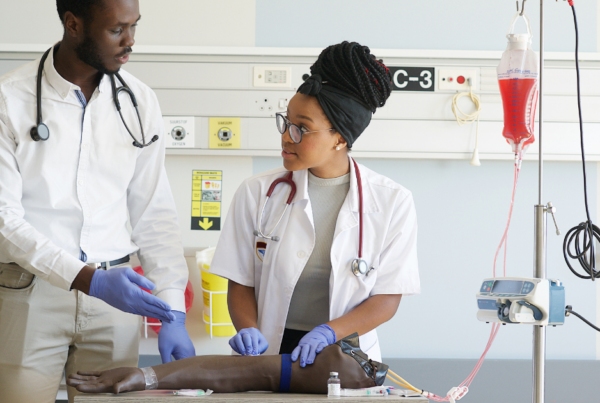The cephalic vein is a prominent superficial vein located in the upper limb, playing a crucial role in venous return and serving as a key site for medical procedures such as intravenous (IV) access, venipuncture, and even surgical grafting. Due to its superficial nature, it is often the first choice for blood draws and IV therapy, making it an essential structure in both routine and emergency medical care. Understanding the cephalic vein anatomy, function, and clinical significance is vital for medical professionals, especially phlebotomists, nurses, and surgeons. Proper knowledge of this vein enables healthcare practitioners to optimize patient care, reduce complications, and improve procedural success rates.
| Key Takeaways: What is the Cephalic Vein? |
| Anatomy: The cephalic vein is located on the lateral side of the forearm and arm, making it accessible for procedures like blood draws and IV placements. |
| Clinical Importance: It is commonly used in venous access for blood draws, IVs, and central lines due to its visibility and ease of access. |
| Cutdown Procedure: The cephalic vein can be surgically exposed for central venous access in emergencies. |
| Varicose Veins: Although rare, varicose veins can develop in the cephalic vein, causing discomfort. |
| Phlebotomy Use: The cephalic vein is a go-to option for phlebotomists when other veins are hard to find. |
| Complications: Risks include nerve injury or accidental artery puncture, requiring careful technique. |
| Clinical Considerations: Knowledge of the cephalic vein’s anatomy is crucial for safe and effective venous access. |
Anatomy of the Cephalic Vein
The cephalic vein originates from the dorsal venous network of the hand and runs along the lateral aspect of the forearm and upper arm. It eventually empties into the axillary vein near the shoulder. Due to its superficial location, it is easily visible and palpable, making it a preferred site for venous access in both clinical and emergency settings.
Key Anatomical Features:
- Location: Runs along the radial (thumb) side of the forearm and arm
- Tributaries: Communicates with the median cubital vein at the elbow
- Termination: Drains into the axillary vein near the deltoid muscle
- Variability: Can present anatomical variations, including duplication or altered drainage patterns, which can impact medical procedures and surgical interventions
- Clinical Accessibility: Readily available for venipuncture, IV therapy, and catheter placement due to its location and size
Origin and Course of the Cephalic Vein
The cephalic vein begins at the dorsal venous network of the hand, specifically the radial part of the network that is located near the anatomical snuffbox. From here, it courses upward through the forearm, passing superficial to the radial styloid process. As it ascends, the vein travels in the superficial fascia, staying on the lateral aspect of the forearm. At the cubital fossa (the area at the bend of the elbow), the cephalic vein communicates with the basilic vein via the median cubital vein.
Function of the Cephalic Vein
The primary function of the cephalic vein is to facilitate venous return from the upper limb to the heart. It plays a vital role in circulatory health by:
- Transporting deoxygenated blood back to the central circulation
- Serving as an access point for IV therapy and blood sampling, ensuring timely medical intervention
- Assisting in thermoregulation by allowing blood to dissipate heat through the skin, helping maintain homeostasis
- Supporting efficient circulation by acting as a conduit for blood flow from superficial veins to deeper venous structures, preventing congestion
Clinical Importance of the Cephalic Vein
1. Venipuncture and IV Access
Due to its superficial location and large diameter, the cephalic vein is often the first choice for IV cannulation, blood draws, and drug administration. Phlebotomists and nurses prefer it when the median cubital vein is inaccessible. In cases where alternative veins are difficult to locate, the cephalic vein provides a reliable site for venous access, ensuring smooth and efficient blood collection and medication delivery. Its accessibility significantly reduces patient discomfort and enhances procedural success rates.
2. Cephalic Vein Cutdown Procedure
In emergency situations where traditional IV access is difficult, a cephalic vein cutdown is performed. This minor surgical procedure allows direct vein access, ensuring rapid administration of fluids and medications. This procedure is particularly valuable in trauma cases, where quick venous access can be life-saving. Emergency and critical care professionals rely on this technique to stabilize patients with compromised vascular access.
3. Use in Cardiac and Vascular Surgeries
The cephalic vein is frequently used in coronary artery bypass grafting (CABG) and arteriovenous fistula (AVF) creation for dialysis patients. Its size and structure make it an excellent candidate for grafting procedures, improving circulation in patients requiring long-term vascular interventions. The use of the cephalic vein in these procedures underscores its versatility in cardiovascular and renal medicine.
4. Common Disorders Associated with the Cephalic Vein
- Thrombophlebitis: Inflammation due to blood clot formation, which can cause pain, swelling, and impaired circulation
- Venous insufficiency: Poor blood return leading to swelling, heaviness, and discomfort in the affected limb
- Cephalic vein aneurysm: A rare condition leading to vein enlargement, potentially causing cosmetic concerns or circulatory issues
- Inadvertent arterial puncture: Mistakenly accessing the nearby artery, which can lead to complications such as hematoma, excessive bleeding, or nerve damage
- Vein sclerosis: Hardening of the vein due to repeated use for IV access, making future venous access challenging and sometimes requiring alternative sites
Cephalic Vein vs. Basilic Vein: Key Differences
| Feature | Cephalic Vein | Basilic Vein |
| Location | Lateral (thumb side) | Medial (pinky side) |
| Depth | More superficial | Deeper in the arm |
| Visibility | Easily visible | Less visible |
| Clinical Use | Preferred for IV and venipuncture | Used for central venous access |
| Accessibility | Easily palpable | Sometimes harder to locate |
| Risk of Complications | Lower | Higher due to proximity to arteries and nerves |
Phlebotomy Tips for Drawing Blood from the Cephalic Vein
- Position the arm properly: Ensure the patient’s arm is well-supported and slightly extended to expose the vein optimally
- Use a tourniquet: Apply it above the puncture site to make the vein more prominent, ensuring effective blood collection
- Choose the right needle size: 21-23 gauge is commonly used for blood draws, but a larger gauge may be required for IV insertion
- Angle the needle correctly: Insert at a 15-30 degree angle for a smooth puncture, avoiding unnecessary trauma to the vein
- Stabilize the vein: Holding the skin taut can help prevent the vein from rolling during the procedure, reducing patient discomfort
- Monitor for complications: Watch for signs of hematoma formation or infiltration, ensuring patient safety and procedural success
FAQs about the Cephalic Vein
What is the function of the cephalic vein?
The cephalic vein plays a crucial role in draining blood from the lateral side of the upper limb. It collects blood from the hand, forearm, and upper arm before draining into the axillary vein. It also provides an accessible site for venous access in clinical procedures.
Why is the cephalic vein used for blood draws?
The cephalic vein is used for blood draws because it is located just beneath the skin, making it easy to locate and access. It is also one of the largest superficial veins in the upper limb, which allows for efficient blood collection.
Can the cephalic vein develop varicose veins?
While varicose veins are more commonly found in the lower limbs, they can develop in the upper limbs, including the cephalic vein. This condition is usually caused by valve incompetence, leading to blood pooling and vein enlargement.
What is the cephalic vein cutdown procedure?
The cephalic vein cutdown is a surgical procedure used to expose the cephalic vein for venous access. It is typically performed when peripheral veins are difficult to locate or when central venous access is required. This procedure is often used in emergency settings or for long-term venous catheter placement.
What are the potential complications of using the cephalic vein for venous access?
While the cephalic vein is a reliable and commonly used site for venous access, complications can arise, such as nerve injury (especially to the radial nerve) or accidental arterial puncture. Careful technique and knowledge of anatomy are essential to minimize these risks.
Conclusion
The cephalic vein is a vital structure in the upper limb, essential for venous return, medical procedures, and surgical applications. Its accessibility makes it a preferred site for IV therapy, venipuncture, and grafting procedures. For medical professionals, understanding its anatomy and clinical relevance ensures safer and more effective patient care. Mastering the cephalic vein functions and potential complications is essential for improving procedural success rates and patient outcomes.
Ready to Master Phlebotomy?
Whether you’re just starting or looking to enhance your skills, Phlebotomy Now School offers expert training and certification programs.
Enroll today and get hands-on experience with venous access techniques, including using the cephalic vein, to jumpstart your career in healthcare!


